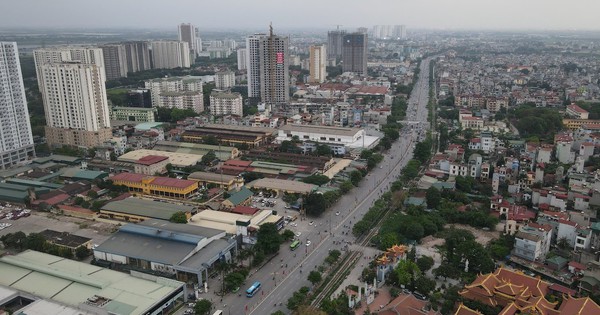The Key Factors That Propel Real Estate
Investing in real estate is a crucial decision that requires careful consideration. Understanding the factors that drive the real estate market is essential for potential investors. In this article, we will explore some of the key elements that create momentum in the real estate industry.
Abundant Opportunities Across the Market
According to reports from Batdongsan.com.vn, the real estate market in Hanoi, specifically in districts such as Dong Anh, Soc Son, Me Linh, and Gia Lam, is experiencing significant growth in supply and transactions. The North Hanoi region benefits from extensive land reserves and a diverse range of real estate offerings. This is due to various infrastructure projects, including Ring Roads 2 and 3, Chương Dương Bridge, Thanh Tri Bridge, and Vinh Tuy Bridge. The North Hanoi area also benefits from the upcoming completion of the Ring Road 3 and several large bridges such as Nhat Tan, Thang Long, and Tu Lien.
In the southern provinces, the completion of multiple ring roads and expressways is creating opportunities for satellite towns and suburban districts such as Binh Duong, Long An, Binh Chanh, and Cu Chi, located near Ho Chi Minh City. Notably, the metro system is shaping the landscape of East Ho Chi Minh City, with associated real estate projects experiencing high price increases. With the completion of major expressways such as Bien Hoa – Vung Tau, Ben Luc – Long Thanh, and Ring Road 3 by 2025, the southern region’s economy is poised for significant growth, creating a surge in real estate development.
The real estate market is displaying positive signs, particularly with upcoming policies expected to be implemented and stimulate recovery from the fourth quarter of 2024. However, it is worth noting that the market still requires time to fully absorb the government’s rescue policies. Boosting investment in major transportation infrastructure projects at localities is a vital catalyst for the real estate market’s early recovery. “Infrastructure always attracts investors’ attention. To ensure safe and effective investments, it is crucial for investors to verify and thoroughly understand information about the region and infrastructure development plans,” highlights Nguyen Van Dinh, Deputy Chairman of the Vietnam Real Estate Association.
Infrastructure: The Gateway to Real Estate Success
A report titled “Infrastructure and Real Estate: Opportunities and Challenges” by the Vietnam Real Estate Institute (VIRES) emphasizes that infrastructure projects nationwide have provided numerous opportunities for localities and real estate investors. However, in many areas, infrastructure planning has led to excessive and unbalanced real estate supply, exceeding actual demand. Additionally, infrastructure development has failed to attract social investment capital and generate breakthrough development for localities. The increasing land speculation has resulted in the proliferation of “paper projects” and soaring land prices.
A thorough assessment of real estate projects associated with transportation infrastructure development is necessary. This evaluation allows for the identification of advantages and the potential to generate capital from land resources post-infrastructure completion. The disbursement of public investments in transportation infrastructure projects has directly and indirectly impacted the real estate market. When large-scale infrastructure projects commence, land resources become available, allowing for industrial, tourism, and service sector expansion. The redistribution of population and labor after infrastructure development benefits the local real estate market. Furthermore, public investment disbursement stimulates economic growth, resulting in a substantial influx of capital into the real estate market.
According to the Ministry of Construction’s statistics, 25 significant transportation infrastructure projects scheduled for implementation between 2023 and 2025 will drive the real estate market’s recovery after the impact of COVID-19 and economic difficulties in 2022. However, to fully leverage urban development opportunities and ensure efficient real estate growth through infrastructure, it is crucial to minimize the risks of unsustainable development. This can be achieved by implementing comprehensive long-term land planning, expediting public investment disbursement, accelerating the progress of transportation infrastructure projects, promoting transparent and open planning information, curbing interest groups, and strengthening land auctions and project bidding processes.
Experts agree that the real estate market plays a pivotal role in urbanization and economic development. To foster sustainable market growth, a symbiotic relationship between the real estate market and transportation projects must be cultivated. The effectiveness of an infrastructure project can only be realized when sustainable real estate projects lead the local economic and social development. On the other hand, real estate projects cannot fulfill their core function as the nucleus of urbanization without well-connected transportation infrastructure. Coordinated and sustainable development is essential in capitalizing on growth opportunities and overcoming challenges in real estate and infrastructure.
In conclusion, understanding the factors that drive the real estate market is essential for potential investors. Abundant opportunities coupled with well-planned infrastructure projects create the momentum needed for real estate success. With careful evaluation and strategic planning, investors can make informed decisions and maximize their returns in the ever-evolving real estate industry.
Click here to learn more about the real estate market and finance through Business Today.

